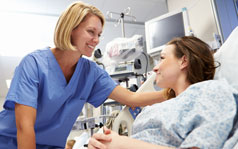Cardiomyopathy
I’ve been told that I have cardiomyopathy. What is it exactly?
Cardiomyopathy refers to diseases of the heart muscle. It can be acquired or inherited. ‘Acquired’ means you aren’t born with the disease but you develop it due to another disease, condition or factor. ‘Inherited’ means your parents passed the gene for the disease on to you. In many cases, the cause of cardiomyopathy remains unknown.
These diseases have a variety of causes, symptoms and treatments. In cardiomyopathy, the heart muscle becomes enlarged, thick or rigid. In rare cases, the muscle tissue in the heart is replaced with scar tissue, making it more difficult for the heart to pump blood properly. The electrical activity is also affected in the heart. As cardiomyopathy worsens, the heart becomes weaker. Depending on the degree of disease, patients can develop heart failure, heart rhythm or valve problems. Heart failure, in turn, can cause fluid to build up in the lungs, ankles, feet, legs or abdomen.
Types:
- Dilated cardiomyopathy
- Hypertrophic cardiomyopathy
- Restrictive cardiomyopathy
- Arrhythmogenic right ventricular dysplasia (ARVD)
What are the symptoms of cardiomyopathy?
- Shortness of breath
- Tiredness
- Unable to exercise
- Weight gain
- Fluid retention
- Palpitations
What causes cardiomyopathy?
- A build up scar tissue
- Inherited from parents
- Haemochromatosis
- Sarcoidosis
- Post chemotherapy or radiotherapy
- Amyloidosis - a build-up of protein products
- Inherited
- Unknown
Some people with earlier forms of cardiomyopathy have no symptoms or only minor symptoms and live a normal life. Other people develop symptoms, which progress and worsen as the heart function deteriorates. The different types of the disease have different causes, signs and symptoms, and outcome.
What treatments are there for cardiomyopathy?
The treatment plan depends on each individual and the cause of the disease. For most it is usually a combination of medications along with adapting your lifestyle, exercise and diet to treat the symptoms.







.jpg?sfvrsn=bc97231b_1)

